I never spent much time thinking about gypsies. I had assumed that gypsies were gypsies, lived in caravans, bred horses and played violins in restaurants. People do stuff. It is probably better to earn money in a restaurant than to spend it there. With the passage of time I became more curious, particularly when definitional battles began to rage about travellers, itinerants, and the Romany peoples, with various spokespersons claiming priority in representing their interests, which often seemed in direct contradiction to other more settled people’s rights. Although all peoples are as ancient as other peoples in chronological fact, the Roma sometimes seemed to be claiming chronological priority, at least as far as their nomadic way of life was concerned.
So, it was with interest and some trepidation that I opened Jelena Cvorovic’s “The Roma: A Balkan Underclass” Ulster Institute for Social Research, 2014. ISBN 978-0-9573913-9-0.
http://www.ulsterinstitute.org/roma.html
Cvorovic concentrates on the Serbian Roma, with whom she has worked for 10 years. I had previously seen a film she had produced, in which different gypsy leaders spent much of their interview time explaining that their particular group were the real thing, and that the other gypsy groups lacked racial purity, and were giving the true Roma a bad name. Somehow, this clashed with the narrative I was expecting, and was possibly willing to support, that they were a minority who had been given a hard time. The film showed disordered settlements, and children living in severe poverty, some giving every appearance of mental backwardness.
Books are a better medium than film to get into details (though the film certainly had an impact). Cvorovic gives the quick background: the Roma are socially excluded (and exclude themselves) with life expectancies 10 to 15 years lower than the European norm, high infant mortality, and an 80% unemployment rate. The Roma, Gypsies, Travellers, Cigani, Manouches, Sinti showed up in Europe from the North West of India between the ninth and fourteenth centuries. No-one knows why. There are an estimated 10 to 12 million living on the margins of European society, either in niche occupations or “living off the land” which in some cases means living off other people’s property. Their code of conduct minimizes contact with non-gypsy people, and particularly abjures marriage with non-gypsies.
With great craftiness they found that Europeans in the Middle Ages received them with Christian charity, and deduced that these kind Europeans would sympathise with Egyptians, who after all had left Egypt searching for the promised land, as the Bible explained. Hence, they called themselves Egyptians, from which eGypt-sies derives, and cast themselves as dispossessed dukes, kings and princes from that land. Christians required documentary proof that these early asylum seekers were legitimate, and the gypsies willingly proffered a forged document from King Sigismund of Hungary, which represented them as penitent pilgrims atoning for their ancestors in Egypt who had rejected Christianity. As a result of the sins of their ancestors they were reduced to wandering the earth as pilgrims seeking charity.
Call me naive, but I think this an intelligent strategy, deficient as it may be in a moral sense. Incidentally, Roma morality is flexible on these sorts of matters: Non-Roma are seen as unclean and polluting, interactions with them are to be avoided, and theft and crimes against non-Roma are not morally wrong. Here are two articles on Gypsies:
http://westhunt.wordpress.com/2013/06/16/godwins-law/
http://ngm.nationalgeographic.com/print/features/world/europe/romania/gypsies-text
I have left out much of the detail on the different Roma groups, but it is worth summarising the chapter on fertility. Cvorovic gives horrific figures for child mortality: 6 per 100 for Christian Orthodox Roma, 13 per 100 for Muslim Roma. By way of comparison, the highest global under-5 death rates are in Africa, at 90 per 1000, and for Europe only 12 per 1000. Hence, the Muslim Roma have the equivalent child mortality of 130 per 1000, and all were dead before their first birthday. Roma mothers were younger than Serbian controls (23 vs 28) and even at that early stage had one third more children (2.42 vs 1.83) gave birth to underweight babies (2815 grams vs 3402 grams) had their first pregnancy far younger (19 vs 29) and had intercourse twice as often per week (5.4 vs 2.5). Maternity hospital staff classified 6.2% of Roma mothers mentally retarded, 3.2% deaf and mute and 1.6 mentally ill. The most likely explanation is inbreeding in very restricted groups, with significant genetic problems. Fertility differences are more striking looking at “ever born” rates (3.7 vs 2.0) and more so in terms of grandchildren (3.16 vs 0.63) for those at the end of childbearing years, though that possibility is, as far as I could see, not directly discussed. The lower the intelligence the higher the number of children r= .509. Within the Roma there is confirmation of dysgenic trends, the lower the intelligence the higher the number of grandchildren r=.25
Assume, if only for a moment, that the Roma are not, as they are painted, a dependent lot of good–for-nothings, but a plucky minority who have been set upon by Europeans, though not set upon so badly that they wish to return to India. In terms of cultural theory, if the locals despise you and won’t let you participate, then you stick to your own kind and your own ways, and do the jobs the locals will not do or cannot do, and charge them the highest prices they can afford. On that account, the Roma should have gone on to great things: specialist crafts, entertainment, controlling the music business, money-lending, gambling, casinos and the like. Their schools should have been hothouses of talent. Indeed, they should have turned out like European Jews.
On the contrary, assessments of their abilities are uniformly low. Cvorovic explains that Roma children are assessed pre-school, and about two thirds diagnosed with “light mental retardation”. She gathers together published intelligence results, mostly using Wechsler tests, on reasonably sized samples and with local populations as comparison groups. After some 8 centuries one ought to be able to put aside the notion that the results are due to delayed acculturation. Adult Roma have intelligence scores very similar to the South Asian stock from which they separated centuries ago. Integration was not sought, and successfully rejected when imposed, programs of improvement failing to have any impact, even under strict Communist command.
For a wide variety of samples the average adult IQs are in the IQ 70 range. There is variation in terms of the countries assessed but as a rule of thumb the scores appear to be two standard deviations below the local norms. This is a very sizeable difference.
Scholastic attainments are usually 1 standard deviation below the mean. However, Roma children seem to be street wise, particularly on their home territories, and observation not investigated further. Their poor scholarship seems to be due to a mixture of low ability and a strong belief that education beyond primary school is of no interest or benefit. Their behaviour in school is often very disruptive. The table below shows English data for school exclusion.
This is an interesting book, drawing together many strands of research, and based on close study of gypsies in Serbia over a decade. I would have like an index and a technical appendix on the research projects reported in the text.
To my mind it shows that if a group of immigrants stick to their own extended family for marriage partners, restrict contact with the host population to the absolute minimum, and stick to their own cultural practices, there is almost zero impact from living in Europe for almost 8 centuries. The climate has done nothing detectable to them for 32 generations, nor has the spurned European culture rubbed off on them by some osmotic process.
The contrast with European Jews is instructive: both are minorities with distinctive cultures and world views; both have inbred to some degree; both have been subject to prejudice, ostracism and very much worse; both have struggled to find a niche in Europe, and yet both have (mostly) remained in Europe. However, there the similarities end, and the differences multiply. European Jews venerated scholarship, the Roma cannot see its purpose. Jews made themselves useful at the highest levels of the economy, barely tolerated but sourly respected for their financial and scholarly acumen. Gypsies made themselves resented at the lowest levels of the economy (though some recently became metal recycling millionaires after the fall of Communist heavy industry) and little respected for wheeling and dealing. Here is a thematic apperception test: what made the difference?
Perhaps it was only a difference in root stock: Roma from India, Jews from Italy.
Although they have made very modest contributions to European culture, and even less to the economy, there is one way the Roma have met with contemporary approval: they have maintained their genetic and cultural purity for roughly 32 generations, the essence of multiculturalism.
Some key references.
Bafekr, S (1999) Schools and their undocumented Polish and “Romany Gipsy” pupils. International Journal of Educational Research, 31(4) 295-302.
Dumitrascu (1999) Intellectual development of gypsy families in Romania. In WJ Donner and DL Dinnel, 14th International Congress of the International Association for Cross-Cultural Psychology, pp173-187. Lisse, The Netherlands, Swets.
Rushton, JP Cvorovic, J and Bons, TA (2007) General mental ability in South Asians: Data from three Roma (Gypsy) communities in Serbia. Intelligence, 35, 1, 1-12.
Bakalar, P (2004) The IQ of gypsies in central Europe. Mankind Quarterly, 44, (3-4) 291-300.
Kezdi,G and Kertesi, G (2011) The Roma/non-Roma test score gap in Hungary. American Economic Review, 101 (3): 519-525.
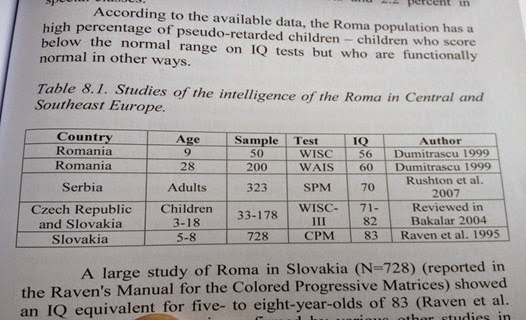
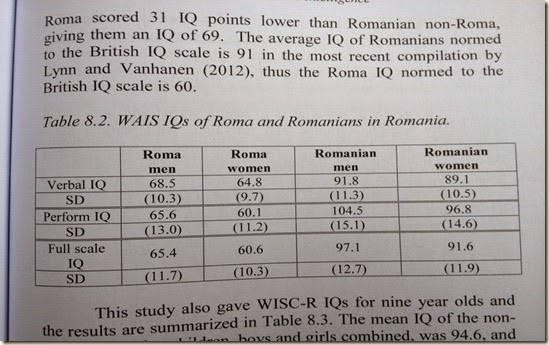
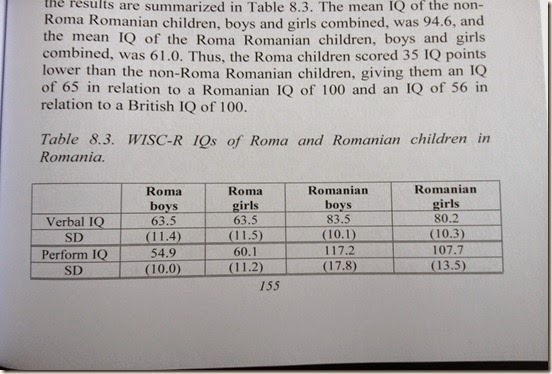
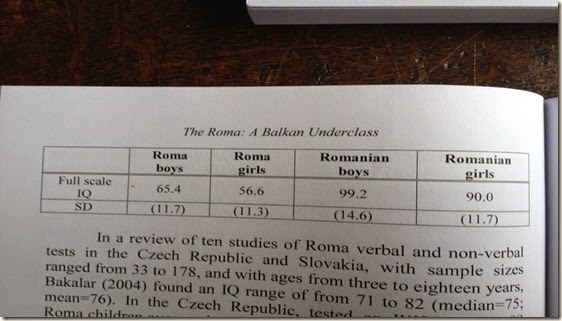
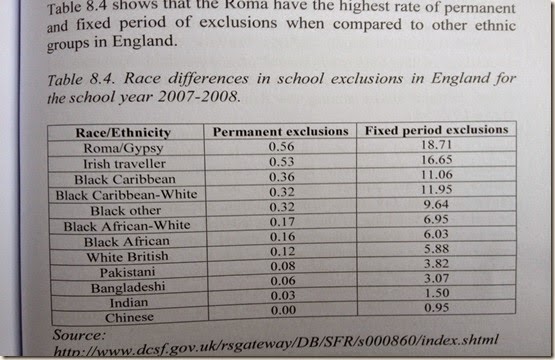

Slightly off-topic but since you are on the Ulster Institute Advisory Council I figure you're in the know. What happened with Nathan Cofnas' Reptiles with a Conscience? All mention of the book seems to have been scrubbed from the Ulster Institutes website.
ReplyDeleteB.B.
Cofnas asked to withdraw it. But the Ulster Institute may have copies, so you could ask them.
Delete"To my mind it shows that if a group of immigrants stick to their own extended family for marriage partners, restrict contact with the host population to the absolute minimum, and stick to their own cultural practices, there is almost zero impact from living in Europe for almost 8 centuries. The climate has done nothing detectable to them for 32 generations, nor has the spurned European culture rubbed off on them by some osmotic process."
ReplyDeleteThis illustrates a key point: about "assimilation." It is generally believed that immigrants will "assimilate" to the native population with time. There are scant true examples of this. But the best ones advocates do point to, one thing has always occurred: admixture. Immigrants become like the native population by becoming one with the native population. When that doesn't happen, we see the results.
@James - I have read this book, and I agree it is extremely interesting and useful; well done for providing an accessible summary!
ReplyDeleteAs an evolutionary psychologist, I should point out that - despite the poor health and low life expectancy of Roma - in biological terms they are wildly successful in modern societies; massively out-reproducing their host populations and expanding as a proportion of the population.
If present trends continue (which they almost never do) the Roma would cease to be a 'small minority' in some places (that have ageing, collapsing native populations) in not too many generations - and then, I guess, the dependent population would pretty soon kill the host, then itself die - or else find new hosts.
"If present trends continue ..." See, e.g., Ferguson, Missouri.
DeleteDear Bruce, I can see your argument, but they should have been able to become very much more populous by now, given several centuries of relative dependency.
ReplyDeleteJames, you may find interesting these papers:
ReplyDelete-Iveta Kovalčíková and Juraj Kresila (2009): How to secure equal opportunities for adequate schooling? Human rights contexts of the Slovak education system relevant to Roma pupils: Meeting students’ learning needs through dynamic assessment. edited by Peter Cunningham, published in London by CiCe. (Verbal IQ tests of gypsy children from the famous slovakian Lunik ghetto- demonstrating a disgenic trend: 1994- 68.8; 2008-62.3)
-. Fania R. Gärtner & Peter J. Tellegen. (2008): The SON-R 5.5-17: A Valid Estimate of Intelligence for Minorities? An Explorative Study on the Usefulness of the SON-R 5.5-17 Intelligence Test for Roma Children. In: Kopcanová (ed.), Equal Access to Quality Education for Children from Socially Disadvantaged Settings (pp. 81-97). Bratislava: The Research Institute for Child Psychology and Patopsychology & Education Section, Slovak Commission for UNESCO. (~78 IQ, low sample size~30)
I missed the url for the first title:
Deletehttps://metranet.londonmet.ac.uk/fms/MRSite/Research/cice/pubs/2009/2009_141.pdf
Many thanks for these helpful references.
DeletePlease taking account that the European gypsy tribes are seem to differ in their cognitive abilities and in the degree of their integration. I mean that Hungarian "romungro" clan is much more integrated in Hungary than the "oláh cigány" and "beás cigány" tribes. The romungros are somehow resemble to the Spanish gitanos in this feature. Interestingly both groups were "domesticated" by the ruling elite in the 18 century (Maria Teresia and Ferdinand VI- "general imprisonment of the gypsies") During this period these roma groups lost their most violent and dumb people. The oláh and beás cigány groups -appeared in Hungary in the 19-20 century (at the end of their slavery in Romania)- missed this process. As I know the fertility rate of romungros and gitanos is near 2 while the other two groups are above 3.
ReplyDeleteThank you. For brevity I had excluded all these historical differences, but I agree that it would be good to get IQ data for as many separate groups as possible, to see to what extent integration (and how many generations ago) influences ability levels and overall achievements.
ReplyDeleteOne thing bothers me here. If WISC tests verbal comprehension (among other things), and given the fact that Roma is culturally self-isolated, isn't the big IQ score difference exactly what one should expect to see? Shouldn't we use "culture free" tests?
ReplyDeleteLook at the first image, where a study by Raven et al. in 1995 found an IQ of 83 for Slovakian Roma on the colored progressive matrices. Of course, given that Flynn Effect gains are virtually *highest* on the Raven, it may be most correct to say that there are no culture free intelligence tests.
DeleteIn any case, the discrepancy between Roma and host populations does appear to be consistent across tests.
Professor Ian Hancock at the University of Texas has advanced an interesting thesis, that the Roma are descended from a multi-caste army that was raised to defend India from the jihad at around the time of the invasion of Mahmud of Ghazi, and that they found themselves behind enemy lines, dispersed and kept moving West. The thesis explains certain interesting aspects of their language, and also their cultural pattern of moving through landscapes and populations without becoming part of them, as one would expect of an independent army marching through foreign territory.
ReplyDeleteThanks for this lead. I cannot find a publications list, but will keep searching for the paper that propounds that particular hypothesis.
DeleteThis comment has been removed by the author.
DeleteThere is an article here, in which Hancock discusses the idea:
Deletehttp://www.radoc.net/radoc.php?doc=art_b_history_origins&lang=en&articles=true
He says:
"An examination of the earliest words in the Romani language suggests a number of things: firstly that there is little in the original, ‘first layer’ Indian vocabulary that reflects a nomadic or itinerant population, but rather it points to a settled one; and secondly that while there are not many original words for e.g. artisan or agricultural skills, there are quite a few military terms. There are Indian words for soldier and attack but not for farmer or harvest; there are words for sword and spear but not for plough or hoe; there is a word for horse but not for buffalo and so on 4. Given these lexical clues and the likely time period (both discussed below), and given that the Indian words and grammar in modern Romani point to the languages spoken in the north-western part of India and to nowhere else, an examination of Indian history for evidence of any military activity during that time and in that area is a natural next step—but first, the time period must be established."
More at the link.
I did find, in village after village in Bihor and Salaj counties, that Transylvanian gypsies - even the children - did pick up new music very quickly, just as the stereotype suggests. Sadly, the dullness in other matters as suggested here was also blatantly obvious. My Romanian sons went to school with many Cigani, and are rather dismissive that any but a few will ever amount to much.
ReplyDeleteTangential: Many observers have attributed Roma nonassimilation to its Marime ideas of ritual purity - largely that the upper half of the body is clean, the lower half unclean. http://www.imninalu.net/marime.htm I didn't see any unambiguous examples of this myself, and wonder if it is exaggerated.
American sources suggest that the ritual uncleanness of gadje (non-Roma) society is concerning to the Roma, and convinces them of their superiority to the population around them. That they observe gadje washing upper body clothes together with lower body clothes, along with table linens, disgusts them.
DeleteYes, they are inbred and yes they have extremely low MEDIAN IQ
ReplyDeletenice!
ReplyDelete